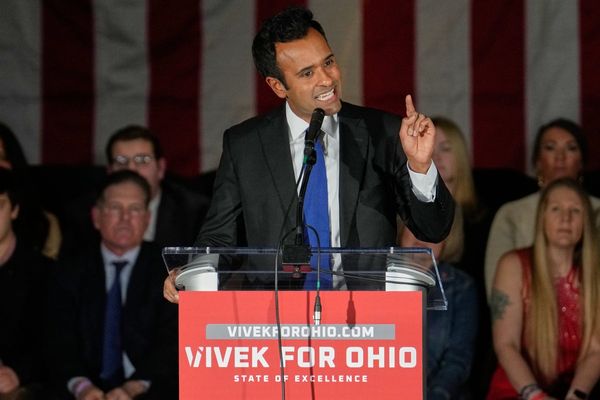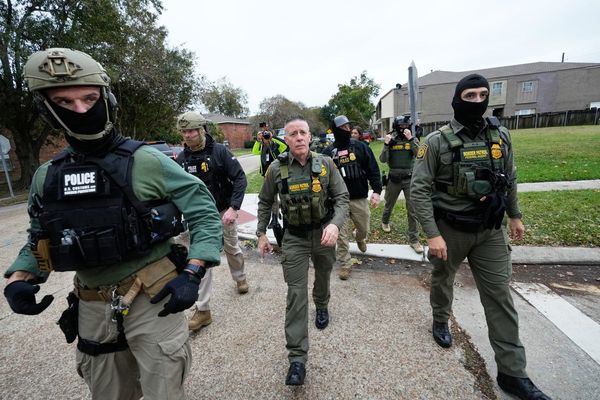
“I often wonder: where did I go wrong?” Graeme Pearman says. “Why didn’t people respond? Is that my responsibility?”
When Guardian Australia meets him at his home on the outskirts of Melbourne, the veteran climate scientist is frustrated.
“If you go through the whole process and the rigour of conducting science, [you think] at the end of the day surely people will understand what you’re saying – they will incorporate those risks into what they do,” he says.
“Well, it doesn’t work that way.
“The reality is that for a period of nearly two decades, Australia went backwards [on climate action]. From a personal perspective, yes, it’s frustrating.”
Outside two alpacas are busy keeping the grass down. A pergola over a deck is heaving with pink wisteria flowers and inside on a kitchen bench Pearman has been struggling with an impossible jigsaw of a Van Gogh painting.
The calmness and lazy beauty of it all is jarring, given we’re here to talk about his life’s work studying a phenomenon that could send countless species extinct, reshape coastlines from rising seas and supercharge storms and wildfires.

More than 50 years ago Pearman was working at the government science agency the CSIRO and measuring how many CO2 molecules were in the air.
He went on to establish the government’s first climate science program and brief three prime ministers (Hawke, Keating and Howard) on climate change. Later, after an acrimonious parting with the CSIRO, he would travel from community groups to fossil fuel company board rooms giving presentations on climate change.
If there is such a thing as the grandfather of Australian climate science, then 82-year-old Pearman is surely a contender.
Six flasks of air
In 1971, in Pearman’s first job at the CSIRO, he and his colleague John Garratt were asked by their boss Bill Priestley to develop, test and then install equipment that could measure how much carbon dioxide there was in the atmosphere.
Every Thursday Pearman and Garratt drew air samples from a 10 metre-high mast above a wheatfield in Rutherglen, Victoria.

What shocked Pearman was that his measurements were a close match to those taken in Hawaii by the US scientist Charles Keeling – 8,600km away and in a different hemisphere.
“The curiosity for the two of us was why should the concentration be the same?” Pearman says. “Above this growing wheat crop – and on the top of a mountain in Hawaii. Two hemispheres that are totally different. Why should that be the case?”
Since the late 1950s Keeling had been finding the amount of CO2 in the atmosphere was creeping up and by the late 60s he was blaming the rise on fossil fuel burning.
Pearman suspected Keeling was wrong and that the rise was down to “drifting standards” in the way the measurements were being taken.
“We thought: he’s got to be wrong. How could humans, mere humans, actually influence the global climate? But within about a year, we knew Keeling was right.”
In 1974 Pearman took six flasks of Australian air samples to laboratories around the world, including Keeling’s, where scientists were also measuring CO2.
Within a few years different readings were being taken from planes and Pearman had helped set up a long-term monitoring station for atmospheric gases at Cape Grim on the north-west tip of Tasmania.
The first carbon dioxide reading at Cape Grim in May 1976 showed CO2 at 328 parts per million. On the day of our interview, the latest reading shows 417 ppm (an increase of 26%).
Australia has just had its warmest winter on record, during what will very likely be the globe’s hottest year on record.
A fact easily forgotten in the blast radius of the last decade of Australia’s climate wars is that in 1990 the Hawke government wanted to introduce a target to cut greenhouse gas emissions by 20% by the year 2005.
In 1989 the UN awarded Pearman and the CSIRO a global award, recognising Australians were as well informed on climate change as almost any other community in the world.
Pearman had organised a conference in 1987 where he had asked scientists working across the economy – from irrigation to agriculture, energy and the natural environment – to present their thoughts on the potential implications of climate change for their sectors.

Pearman would eventually make his way through the ranks to become the chief of CSIRO’s atmospheric research division.
By the early 1990s it seemed Australia was well positioned and well informed.
But Pearman admits he was naive to think that policy and action would just follow the science.
Political pressure and vested interests
Just as Pearman and his colleagues were telling the public and politicians about the risks from climate change, Australia’s fossil fuel industries were bringing their weight and cash to the policy table. Ultimately the science was outgunned by vested interests.
In 2003 Pearman joined the Australian Climate Group – a group of experts convened by WWF and a multinational insurance group. In 2004 the group released a report saying Australia should cut its emissions by 60% by 2050.
Joining this group would be Pearman’s downfall.
He suspects – but doesn’t know for sure – that CSIRO had come under “a huge amount of pressure” from the government because of the group’s suggestions that fossil fuel use would need to be curtailed.
“I think it was from a government level of some sort to say that we don’t want people actually talking down the future of these particular commodities,” he says. “And I don’t think I ever did that – I simply pointed out what the consequences of pursuing that future would be.
“So all of a sudden I found myself in a discussion … about how it might be a good time to go. I felt devastated.”
Pearman took an academic role at Monash University and started a consultancy to provide briefings on the latest science to industry and the community.
He has racked up more than 500 presentations and continues to write scientific papers.
But he continues to be frustrated at the lack of action.
“We still have people talking about utilising massive gas reserves that should never come out of the ground. Because whether we burn them or someone else burns them, they will contribute to further warming.
“We’ve got to stop this. Not just Australia, but the global community. But Australia should be leading the way, not dragging its feet.”

Pearman is an instinctively optimistic character, but the country’s continued promotion of fossil fuels is causing that optimism to become “overwhelmed by pessimism” about the future.
It is part of the human condition to care about other species, he says. But at the same time “it is us as humans that have created this way of looking at the world – created the importance of wealth generation compared with other values that we might have”.
“And we’re not going to turn that around very quickly.”
What does give Pearman “some sense of security” for the future is that young people are well informed.
“I think they need to have courage – to find courage if they haven’t got it – to accept that the world is different and needs to be different into the future and that they should stand up and be part of the transition.
“The older people of the community have had their time. It’s their time now.
“Stand up and take responsibility and do what you think is necessary.”
In Weight of the world: a climate scientist’s burden, we hear how three pioneering scientists made their discoveries, the personal toll it took on them, and how, during the hottest year on record, they stay hopeful. Experience the full series here







